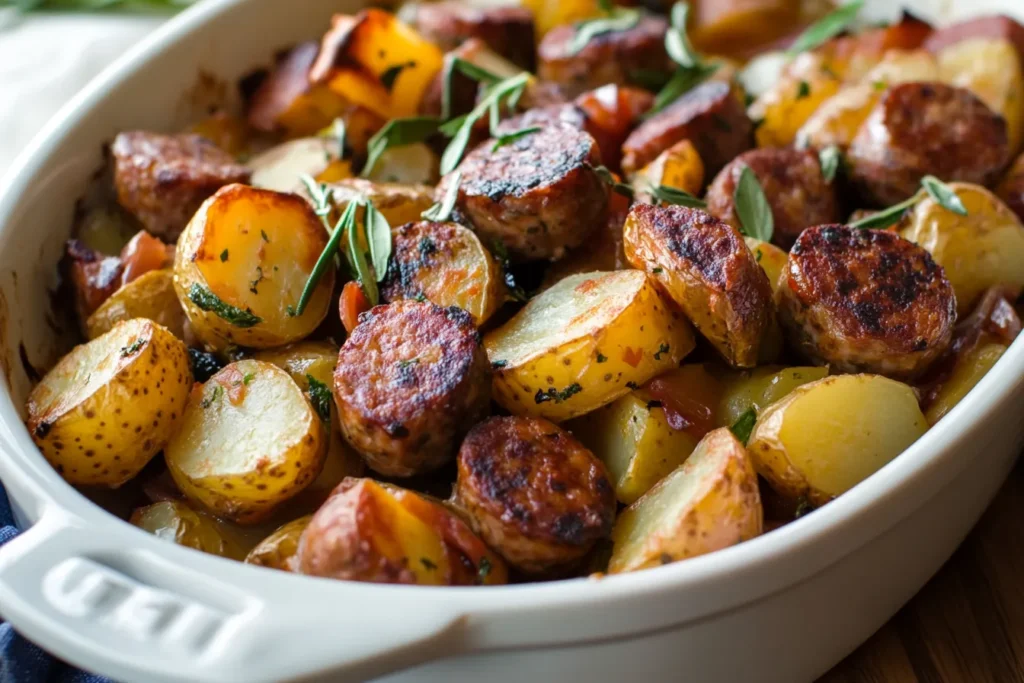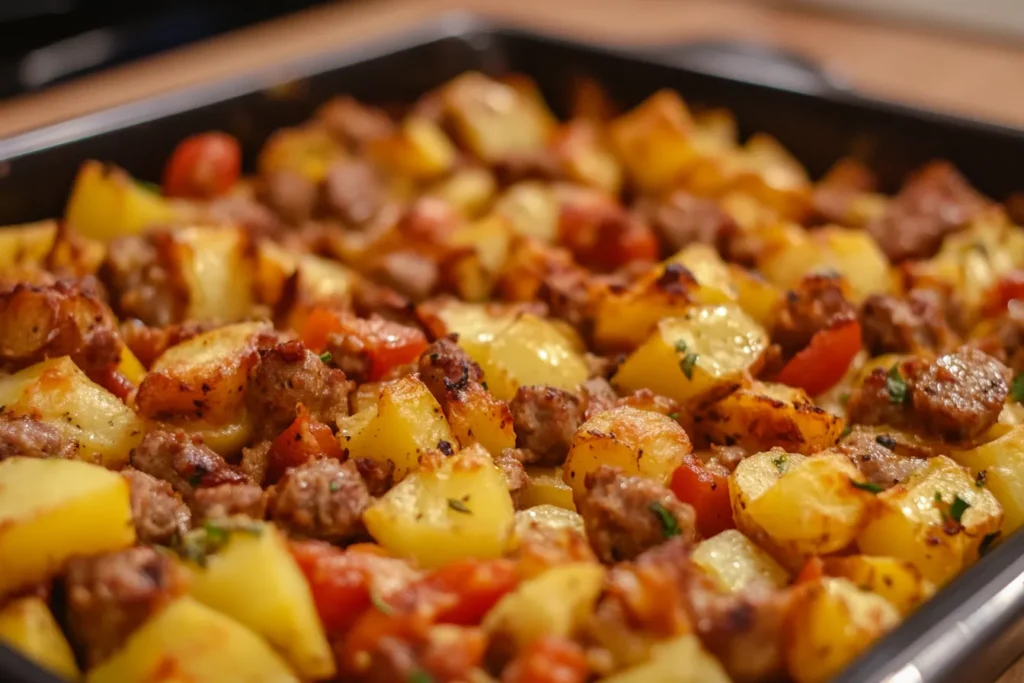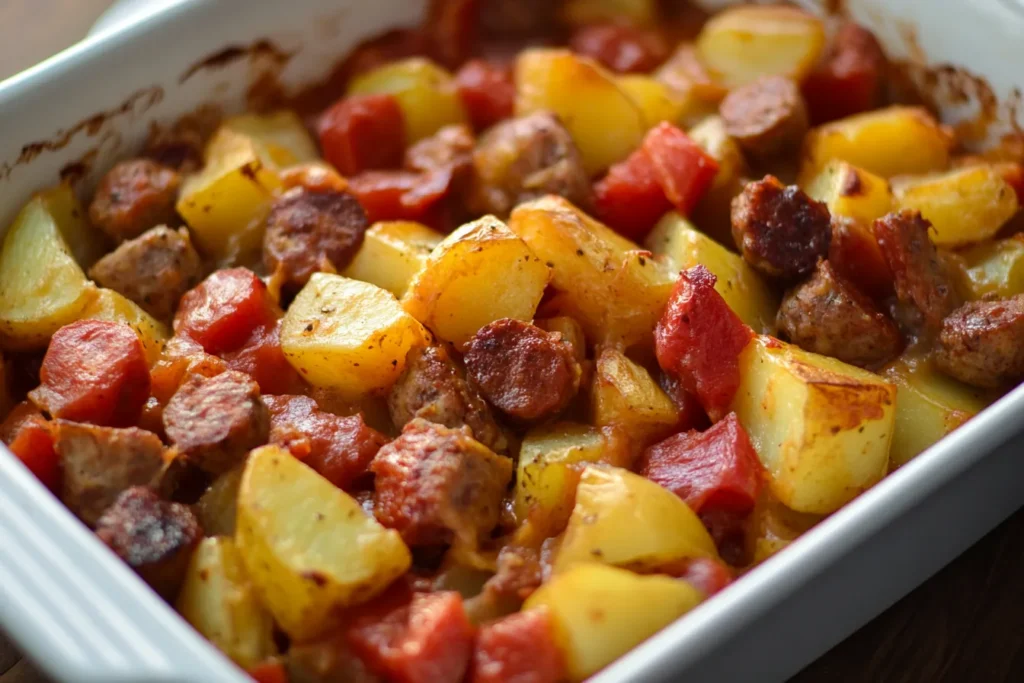Have you ever found yourself wondering what to make for dinner that’s hearty, comforting, and easy to throw together? Italian Sausage Casserole might just be the answer you’re looking for. Packed with bold flavors, tender potatoes, and juicy sausage, this dish is a lifesaver for busy weeknights or when you need a crowd-pleaser that doesn’t require hours in the kitchen. Whether you’re feeding a family or meal prepping for the week, this casserole brings the perfect balance of convenience and satisfaction. Let’s dive into a recipe that’s as simple as it is delicious!
List Of Contents
What Is Italian Sausage and Potato Casserole?
Italian Sausage and Potato Casserole is a hearty, flavorful dish that combines savory Italian sausage with tender, golden-baked potatoes. This casserole, rich in textures and tastes, has become a favorite for family dinners and potluck events due to its simplicity and versatility. Whether you’re a seasoned cook or just starting out, this dish promises a rewarding experience in every bite.
Unlike other one-dish meals, this casserole seamlessly balances protein, carbohydrates, and a medley of spices. The result? A dish that’s not only satisfying but also perfect for a crowd. It’s the ultimate comfort food, filling kitchens with irresistible aromas of garlic, rosemary, and sizzling sausage. Check out more recipes here.
The Origins of Italian Sausage in Culinary Traditions
Italian sausage is deeply rooted in the culinary heritage of Italy. Traditionally seasoned with fennel, garlic, and other herbs, this sausage reflects the rich, regional diversity of Italian cooking. Historically, Italian sausages were created as a way to preserve meat, evolving over centuries to include endless variations in spices and preparation methods.
When paired with potatoes—a staple ingredient in many cuisines—this casserole embodies the essence of comfort food with its earthy, rustic flavors. The fusion of Italian-inspired ingredients with hearty potatoes makes this dish a true crowd-pleaser.
Why Potatoes Make the Perfect Pairing for Sausage
Potatoes are not only versatile but also act as a neutral canvas, allowing the bold flavors of Italian sausage to shine. Their texture complements the juicy, spiced sausage, and when baked together, they develop a delectable crispy crust. From buttery Yukon Golds to starchy Russets, potatoes elevate this casserole into a well-rounded meal.
Plus, potatoes absorb the juices and spices from the sausage, creating layers of flavor that are unmatched in simplicity and taste. Check out more recipes here.
Benefits of Making Casseroles at Home
- Cost-Effective: Casseroles use pantry staples and minimal ingredients, making them budget-friendly.
- Customizable: You can easily adjust the recipe to suit dietary needs or preferences.
- Time-Saving: With preparation and cooking combined, you’ll save hours compared to preparing separate side dishes.
- Meal Prep Friendly: Leftovers store beautifully, making this dish perfect for busy weeknights or meal prep.
Key Ingredients for the Recipe

Selecting the Right Type of Italian Sausage
Italian sausages come in various types, from sweet to spicy. To choose the best sausage for your casserole:
- Sweet Italian Sausage: Mild, flavored with fennel, perfect for family-friendly meals.
- Spicy Italian Sausage: Adds heat and depth of flavor, ideal for those who enjoy a kick.
- Chicken or Turkey Sausage: Leaner options for a healthier twist without compromising on taste.
Check out more recipes here.
Choosing the Best Potatoes for the Dish
Selecting the right potatoes is crucial for texture:
- Yukon Golds: Creamy and hold their shape well.
- Russet Potatoes: Perfect for a fluffy, melt-in-your-mouth texture.
- Red Potatoes: Offer a firmer bite, great for chunkier casseroles.
Essential Herbs and Spices
To bring authentic Italian flavors to your casserole:
- Garlic cloves or powder
- Fresh rosemary and thyme
- Crushed red pepper flakes (for heat)
- Italian seasoning blend
Optional Add-ins: Vegetables, Cheese, and More
Elevate the casserole with:
- Vegetables: Bell peppers, onions, or zucchini for added nutrition.
- Cheese: Mozzarella, Parmesan, or a sprinkle of Gruyère for a creamy top layer.
- Cream or Broth: For a saucier consistency, add a splash of heavy cream or chicken broth.
Prepping for the Perfect Casserole
Cleaning and Prepping Potatoes
- Scrub potatoes thoroughly to remove dirt.
- Peel or leave skins on, depending on your preference.
- Cut into uniform chunks (about 1-inch pieces) for even cooking.
Preparing Sausages for Optimal Flavor
- Remove casing: For crumbled sausage texture, remove the casing before cooking.
- Brown the sausage: This step enhances flavor by caramelizing the meat.
Chopping Techniques for Uniform Cooking
- Consistency is key: Uniform pieces ensure every bite is cooked evenly.
- Knife skills: Use a sharp knife to make precise cuts.
Ensuring Balanced Flavor Profiles
Layering is essential:
- Start with a bed of seasoned potatoes.
- Add a layer of browned sausage.
- Incorporate optional vegetables and top with cheese for a golden crust.
Check out more recipes here.
Equipment Needed
Must-Have Casserole Dish Options
Choose a durable casserole dish that distributes heat evenly:
- Glass or ceramic dishes are ideal for retaining heat.
- A cast-iron skillet offers a rustic presentation and doubles as a cooking tool.
Tools for Chopping and Mixing
- Sharp chef’s knife for slicing.
- Cutting board to keep prep clean.
- Mixing bowls for seasoning and tossing ingredients.
Check out more recipes here.
Oven Requirements and Temperature Controls
- Preheat the oven to 375°F (190°C).
- Use an oven thermometer for accuracy if your oven runs hot or cool.
Nutritional Breakdown

Caloric Content of Italian Sausage and Potato Casserole
A typical serving contains around 350–450 calories, depending on add-ins like cheese or cream. This dish offers a balanced combination of:
- Protein from the sausage.
- Carbohydrates from the potatoes.
- Fats from cheese or oil.
Macronutrient Breakdown
- Protein: Approximately 20–25 grams per serving.
- Carbs: Around 30–40 grams.
- Fats: Varies based on sausage type and cheese used, typically 15–20 grams.
How to Make It Healthier
- Swap regular sausage for lean turkey or chicken sausage.
- Use sweet potatoes or cauliflower for fewer carbs.
- Reduce cheese or opt for low-fat versions.
Step-by-Step Recipe Instructions
1. Preheating the Oven: Getting Started
Before you begin assembling your casserole, preheat your oven to 375°F (190°C). Preheating ensures the casserole cooks evenly and develops a crispy, golden-brown top.
- Lightly grease your casserole dish with olive oil or non-stick spray to prevent sticking.
- If you’re using parchment paper, cut it to size and line the bottom for easy cleanup.
2. Cooking the Sausages: Browning for Depth of Flavor
The key to a flavorful casserole is properly browned sausage. Follow these steps:
- Heat a skillet over medium-high heat with a drizzle of olive oil.
- Remove sausage from casings (if necessary) and crumble into bite-sized pieces.
- Cook until the sausage is browned, about 5–7 minutes, stirring occasionally. This process caramelizes the meat, unlocking its rich flavors.
- Set aside the cooked sausage to cool slightly.
3. Parboiling Potatoes for Texture Consistency
To achieve the perfect potato texture, parboil them before baking:
- Bring a large pot of salted water to a boil.
- Add diced potatoes and cook for 5–7 minutes. They should be tender but not fully cooked.
- Drain the potatoes and let them cool slightly before layering.
4. Layering Ingredients in the Casserole Dish
Layering ensures every bite is infused with flavor:
- First Layer: Spread a layer of parboiled potatoes on the bottom of the dish. Season with salt, pepper, and Italian herbs.
- Second Layer: Add the browned sausage evenly over the potatoes.
- Optional Vegetables: Add chopped bell peppers, onions, or zucchini for extra flavor and nutrients.
- Cheese (Optional): Sprinkle shredded mozzarella or Parmesan for a creamy finish.
- Repeat: Continue layering until all ingredients are used.
Finish with a sprinkle of breadcrumbs or more cheese on top for a crispy crust.
Cooking Techniques for Better Flavor

Using Fresh Herbs and Spices for Authentic Taste
Fresh herbs elevate the dish with vibrant, authentic flavors:
- Add chopped rosemary and thyme directly to the potatoes for an aromatic base.
- Garnish with fresh parsley after baking for a burst of color and flavor.
Creating a Crispy Top with Cheese or Breadcrumbs
For a crunchy, golden crust:
- Combine breadcrumbs with grated Parmesan and a drizzle of olive oil.
- Sprinkle this mixture on top before baking.
- Broil the casserole for 2–3 minutes at the end to achieve a perfect crispy finish.
Tips for Even Cooking
- Spread ingredients evenly across the dish to prevent overcooked or undercooked spots.
- Rotate the casserole halfway through baking for uniform heat distribution.
Adjusting Timing Based on Oven Type
- If using a convection oven, reduce the temperature to 350°F (175°C) and monitor closely.
- Standard ovens may require an extra 5–10 minutes of baking time.
Variations on the Recipe
Substituting Sweet Potatoes for a Unique Twist
Sweet potatoes add a hint of natural sweetness that pairs beautifully with spicy sausage. To use them:
- Follow the same parboiling process.
- Season with cinnamon or paprika for an extra layer of flavor.
Using Turkey Sausage for a Leaner Option
For a healthier casserole:
- Substitute Italian pork sausage with turkey or chicken sausage.
- These options are lower in fat while still offering bold flavors.
Adding Cream or Broth for Extra Richness
To create a saucier casserole:
- Whisk together 1 cup of heavy cream or chicken broth with 1 teaspoon of flour.
- Pour over the layers before baking for a creamy, decadent finish.
Vegetarian Version: Meatless Sausage Alternatives
For a vegetarian twist:
- Use plant-based sausage crumbles.
- Substitute potatoes with cauliflower or squash for a lighter version.
Serving Suggestions
Best Side Dishes to Complement the Casserole
Enhance your meal with these sides:
- Garlic Bread: Perfect for soaking up the casserole’s juices.
- Roasted Vegetables: Pair with roasted asparagus, Brussels sprouts, or a medley of carrots.
- Mixed Green Salad: A fresh, tangy salad balances the casserole’s richness.
Perfect Wine Pairings for Italian Sausage Casserole
The bold flavors of the casserole pair beautifully with wine:
- Red Wines: Chianti or Sangiovese bring out the sausage’s spices.
- White Wines: A crisp Pinot Grigio complements the creamy and cheesy notes.
Serving Sizes: Adjusting for Family or Guests
- For smaller gatherings, use a 9×9-inch dish and halve the recipe.
- For larger events, opt for a 9×13-inch dish and double the ingredients.
Common Mistakes to Avoid
Overcooking or Undercooking the Sausage
- Avoid overcooking sausage during browning. It should be golden but not dry.
- Ensure sausage is fully cooked before layering into the casserole.
Making the Dish Too Oily: How to Prevent It
- Use leaner sausages or drain excess fat after browning.
- Avoid excessive oil when sautéing vegetables.
Uneven Cooking: Tips for Layering Ingredients Properly
- Spread ingredients in thin, even layers for consistent cooking.
- Pre-cook dense vegetables (like carrots) to avoid undercooking.
Italian Sausage and Potato Casserole: Storing, Variations, and Expert Tips
Storing and Reheating Instructions
Proper storage ensures your casserole remains flavorful and safe to eat:
- Cool Before Storing: Let the casserole cool to room temperature before transferring it to the refrigerator. Hot food can raise the fridge’s temperature and affect other stored items.
- Airtight Containers: Use airtight containers to keep the casserole fresh and prevent it from absorbing other odors in the fridge.
- Layer Separation: For better reheating, consider storing separate layers (if practical).
Reheating Without Losing Flavor or Texture
Reheating a casserole requires care to avoid drying it out:
- Oven Method:
- Preheat the oven to 350°F (175°C).
- Transfer the casserole to an oven-safe dish and cover with aluminum foil.
- Heat for 20–30 minutes or until warmed through.
- Microwave Method:
- Place a portion on a microwave-safe plate.
- Cover with a microwave lid or damp paper towel to retain moisture.
- Heat in 2-minute intervals until hot.
Freezing Casserole for Meal Prep
To freeze your casserole for future meals:
- Before Baking:
- Assemble the casserole in a freezer-safe dish.
- Wrap tightly with plastic wrap and aluminum foil.
- Label with the date and freeze for up to 3 months.
- After Baking:
- Cool completely before freezing.
- Portion into individual servings for easier reheating.
Shelf Life: How Long Does It Last?
- Refrigerated: 3–5 days.
- Frozen: Up to 3 months for best quality.
FAQs
- Can I Use Pre-cooked Sausage? Yes, pre-cooked sausage works well. Simply slice it and skip the browning step. This saves time but may slightly reduce the depth of flavor.
- What’s the Best Way to Prevent the Casserole from Drying Out?
- Cover the casserole with foil while baking.
- Add a liquid component, such as cream or broth, to keep it moist.
- Can I Make It in an Instant Pot or Slow Cooker? Absolutely! For an Instant Pot, use the sauté setting to brown the sausage, layer the ingredients, and cook on high pressure for 15 minutes. For a slow cooker, assemble the casserole and cook on low for 6–8 hours or high for 3–4 hours.
- What Cheese Works Best for This Dish? Mozzarella, Parmesan, and Gruyère are excellent choices. For a smoky twist, try Gouda.
- Can I Replace Potatoes with Other Vegetables? Yes, cauliflower, sweet potatoes, or butternut squash make great low-carb or flavor-enhanced substitutions.
- Is It Safe to Assemble the Casserole Ahead of Time? Definitely! Assemble it up to a day in advance and refrigerate. Bring it to room temperature before baking for even cooking.
- How Do I Avoid Soggy Potatoes? Parboil the potatoes before baking and ensure they’re well-drained to maintain their texture.
- What Can I Serve with This Dish for a Complete Meal?
- A fresh salad or steamed greens.
- Crusty bread or garlic knots.
- Light soups like minestrone.
- How Do I Reduce the Dish’s Sodium Content? Use low-sodium sausage and cheese. Season sparingly with salt and rely on fresh herbs for flavor.
- Can I Double the Recipe? Yes, double the ingredients and bake in a larger casserole dish. Adjust the baking time as needed.
